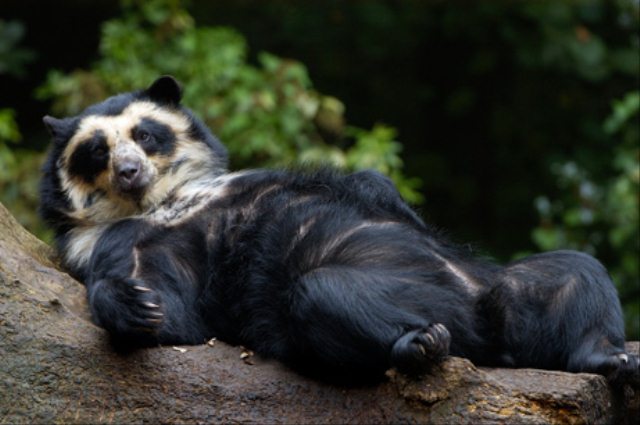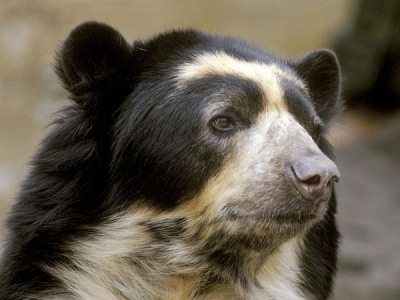Paddington Bear

|
The Spectacled Bear (Tremarctos ornatus), also known as the Andean Bear and locally as ukuko, jukumari or ucumari is the last remaining 'short-faced' bear (subfamily Tremarctinae) and the closest living relative to the Florida spectacled bear and short-faced bears of the Middle Pleistocene to Late Pleistocene age. The Spectacled Bear is a relatively small species of bear native to South America. It has black fur with a distinctive beige-coloured marking across its face and upper chest. Males are a third larger than females. Males can weigh 286 – 440 pounds, and females 77 – 181 pounds They are found in several areas of northern and western South America, including eastern Panama, western Venezuela, Colombia, Ecuador, Peru, western Bolivia, and northwestern Argentina. Spectacled bears are the only surviving species of bear native to South America, and the only surviving member of the subfamily Tremarctinae. Their survival has depended mostly on their ability to climb even the tallest trees of the Andes.
 Paddington trying 'The Dark Side' - Marmite
Naming and etymology: Tremarctos ornatus is commonly referred to in English as the "Spectacled Bear", a
reference to the light colouring on its chest, neck and face which may resemble
eyeglasses in some individuals, or the "Andean Bear" for its distribution along
the Andes. The root term -
comes from a Greek word meaning "hole;" arctos is the Greek word for "bear."
Tremarctos is a reference to an
unusual hole on the animal's humerus. Ornatus, Latin for
"decorated", is a reference to the markings that give the bear its common
English name. Behavior and diet: Although the bears tend to isolate themselves from one another to avoid competition, they are non-territorial. When encountered by humans or other Spectacled Bears, they will react in a docile but cautious manner, unless the intruder is seen as a threat or a mother's cubs are endangered. Like other bears, mothers are protective of their young and have attacked poachers. However, no deaths have been recorded by South American state governments. They usually attempt to retreat from humans, often by climbing trees. Once up a tree, they often build a platform, perhaps to aid in concealment, as well as to rest and store food on. Spectacled Bears are more vegetarian than other bears; normally about 5% of their diet is meat, in the form of small mammals and birds, arthropods and carrion. They are occasionally accused of killing livestock and raiding corn fields.
Conservation: The spectacled bear population is under threat for a number of
reasons. The bears are hunted by locals due to a belief they will eat livestock
(although spectacled bears do not eat large quantities of meat). The gall
bladders of spectacled bears are also valued in traditional
Chinese medicine and can fetch a high price on the international market. Extensive
logging and farming have led to a loss of habitat for the
bears. In the documentary Paddington Bear: The Early Years, British actor Stephen Fry encounters a Spectacled bear called Yogi, who was kept in a small cage by Andean villagers (see also Paddington Bear). Fry bartered with the villagers to have the bear released and it was taken to an enclosure in Machu Picchu. Fry's interest in the bears led to the follow up documentary, Stephen Fry and the Spectacled Bears, and he also wrote and published his experiences in rescuing the Spectacled Bear: A Peruvian Diary. In the BBC television programme Serious Andes a team of eight teenagers build a pre-release enclosure for two spectacled bears before returning them to the wild.
ALL IN ALL STILL LOOKING |




